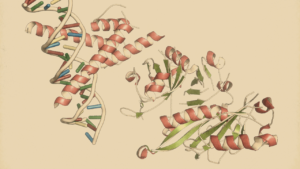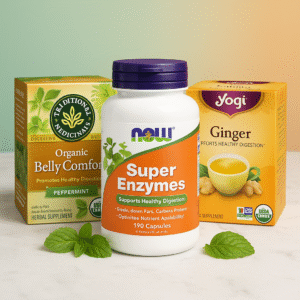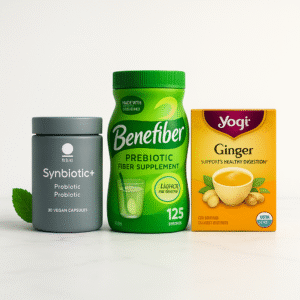Probiotic vs. Prebiotic: Discover 3 Amazing Main Differences
Compare probiotic vs. prebiotic supplements to improve gut health. Find the right supplement for your needs and incorporate them into your diet.

Probiotic vs. prebiotic: Understand the difference between these two supplements that can help improve gut health. Learn how they benefit and how to incorporate them into your diet for optimal digestive health.
In this Article
What Are Probiotics and Prebiotics?
The fascinating world of probiotics has a century-long history, starting with Elie Metchnikoff's groundbreaking idea that lactic acid bacteria could have health benefits that promote longevity.
As a result, nonpathogenic bacteria have been used to modify the intestinal microbiota to treat intestinal disorders.
Early discoveries by Henry Tissier✅, who found Bifidobacterium in a breast-fed infant, and Dr. Minoru Shirota, who identified Lactobacillus casei strain Shirota to combat diarrheal outbreaks, were significant in the field's development.
Today, there have been over 1500 trials published on probiotics and close to 350 on prebiotics, making it an exciting area of research with promising potential.
Prebiotics, a concept proposed by Gibson and Roberfroid in 1995, are non-digestible substances that can positively influence beneficial microbes in the gut to provide health benefits to the host.
When combined with probiotics, they aim to improve the gut environment, which is home to trillions of commensal microbes, ultimately leading to better human health.
Probiotics are live microorganisms that offer health benefits when consumed in adequate amounts✅.
The most commonly used probiotics are Lactobacillus and Bifidobacterium, but other species, such as Saccharomyces boulardii and certain E. coli and Bacillus species, are also used.
The term "probiotic" should only be used for live microbes that have been proven to provide health benefits through controlled human studies.
Lactic acid bacteria, including Lactobacillus species, have been used for food preservation through fermentation for thousands of years and may provide additional health benefits.
Fermentation is a widely used method for preserving various raw agricultural materials.
Prebiotics are dietary substances made of nonstarch polysaccharides and oligosaccharides. They are used in many food products such as biscuits, cereals, chocolate, spreads, and dairy products. Examples of prebiotics include:
- Oligofructose
- Inulin
- Galacto-oligosaccharides
- Lactulose
- Breast milk oligosaccharides
Lactulose is a synthetic disaccharide used as a drug for the treatment of constipation and hepatic
encephalopathy.
The prebiotic oligofructose is found naturally in many foods, such as wheat, onions, bananas, honey, garlic, and leeks.
Oligofructose can also be isolated from chicory root or synthesized enzymatically from sucrose.
Fermentation of oligofructose in the colon results in a large number of physiologic effects,
including:
- Increasing the numbers of bifidobacteria in the colon
- Increasing calcium absorption
- Increasing fecal weight
The following table presents distinct definitions of probiotics and prebiotics and highlights their differences from other related terms:
| Term | Definition |
|---|---|
| Probiotics | Live microorganisms that confer a health benefit on the host when administered in adequate amounts. |
| Prebiotics | Selectively fermented ingredients result in specific changes in the composition and/or activity of the gastrointestinal microbiota, thus conferring benefit(s) upon host health. |
| Synbiotics | Products that contain both probiotics and prebiotics, with conferred health benefits. |
| Lactic acid bacteria (LAB) | Functional classification of nonpathogenic, nontoxigenic, Gram-positive, fermentative bacteria that are associated with the production of lactic acid from carbohydrates, making them useful for food fermentation. |
| Fermentation | A process by which a microorganism transforms food into other products, usually through the production of lactic acid, ethanol, and other metabolic end products. |
Differences Between Probiotics vs. Prebiotics
Probiotic vs. Prebiotic: 3 Key Differences:
Definition:
Probiotics: According to the International Scientific Association for Probiotics and Prebiotics (ISAPP), probiotics are live microorganisms that, when administered in adequate amounts, confer a health benefit on the host✅.
Prebiotics: The ISAPP defines prebiotics as substrates that are selectively utilized by host microorganisms, conferring a health benefit. Prebiotics are non-digestible food ingredients that stimulate the growth and activity of beneficial bacteria in the gut.
Mechanism of Action:
Probiotics work by directly introducing beneficial bacteria into the gut. These live microorganisms can colonize the gut and restore the balance of the gut microbiota, thereby promoting digestive health and immune function.
Prebiotics, on the other hand, act as a food source for the beneficial bacteria already present in the gut. They selectively stimulate the growth and activity of these bacteria, leading to a shift in the composition of the gut microbiota towards a more favorable balance.
Sources:
Probiotics can be found in various fermented foods, such as yogurt, kefir, sauerkraut, and kimchi. They can also be taken in the form of dietary supplements.
Prebiotics are naturally present in certain foods, including whole grains, fruits, vegetables, and legumes. Common sources of prebiotics include inulin, fructooligosaccharides (FOS), and galactooligosaccharides (GOS).
Prebiotics vs. probiotics work together to improve gut health. Prebiotics feed the good bacteria in your gut, while probiotics help to keep the good bacteria healthy. When you eat prebiotic-rich foods and take probiotic supplements, you are giving your gut the best chance of staying healthy.
Learn more:
How I Take Probiotic Supplements with Prebiotics
Probiotic Selection:
Probiotic strains must meet safety, functionality, and technological criteria during selection.
Characteristics are determined by carefully selected strains of a particular species, while safety is defined by origin, absence of pathogenic cultures, and antibiotic resistance.
Functional aspects define survival in the gastrointestinal tract and immunomodulatory effects.
Probiotics must maintain properties during storage and distribution, with documented pro-health effects consistent with marketed products.
The type of carrier/matrix is important, as it may reduce viability, altering product properties.
Criteria for selecting probiotic strains✅✅:
| Criteria | Description |
|---|---|
| Resistance to bacteriocins and acids | Ability to withstand the acidic environment and bacteriocins produced by the endogenous microbiota in the gastrointestinal tract |
| Adherence and colonization | Ability to adhere to and colonize specific sites within the host organism, particularly in the gastrointestinal system |
| Technological usability | Easy production of high biomass amounts, viability and stability during preparation and distribution, high storage survival rate, genetic stability, and resistance to bacteriophages |
Prebiotic Selection:
According to Wang (2009)✅, there are five basic criteria for the classification of food components such as prebiotics:
- Prebiotics should not be fully digested in the upper segments of the alimentary tract and should selectively stimulate the growth of microorganisms with a beneficial effect on health.
- Prebiotics should lead to increased production or a change in the relative abundance of different short-chain fatty acids (SCFAs), increased stool mass, moderate reduction of colonic pH, reduction of nitrous end products and fecal enzymes, and an improvement of the immunological system.
- Prebiotics should stimulate the growth and/or activity of intestinal bacteria associated with health protection and well-being.
- Prebiotics must be able to withstand food processing conditions and remain unchanged, non-degraded, or chemically unaltered and available for bacterial metabolism in the intestine.
- Prebiotic substances should cause a reduction of colon cancer risk factors.
Specify choose features of the best probiotic and prebiotic products:
Benefits and Side Effects of Probiotics vs. Prebiotics
Benefits of prebiotics and probiotics:
A synbiotic is a probiotic and prebiotic combination that promotes a healthy gut bacteria balance.
Synbiotics are used not only for the improved survival of beneficial microorganisms added to food or feed but also for the stimulation of the proliferation of specific native bacterial strains present in the gastrointestinal tract
When creating a synbiotic formula, choose a probiotic and prebiotic that benefit the host's health when used separately. The prebiotic should selectively stimulate the growth of beneficial microorganisms.
A combination of Bifidobacterium or Lactobacillus genus bacteria with fructooligosaccharides in synbiotic products seems to be the most popular.
The table below gives the benefits of probiotics vs. prebiotics separately:
| Probiotics | Prebiotics |
|---|---|
| Immunologic benefits | Metabolic effects: |
| - Activate local macrophages to increase antigen presentation to B lymphocytes and increase secretory immunoglobulin A (IgA) production both locally and systemically - Modulate cytokine profiles - Induce tolerance to food antigens | - Production of short-chain fatty acids - Absorption of ions (Ca, Fe, Mg) |
| Nonimmunologic benefits | Enhancing host immunity: |
| - Digest food and compete for nutrients with pathogens - Alter local pH to create an unfavorable local environment for pathogens - Produce bacteriocins to inhibit pathogens - Scavenge superoxide radicals - Stimulate epithelial mucin production - Enhance intestinal barrier function - Compete for adhesion with pathogens - Modify pathogen-derived toxins | - IgA production, cytokine modulation, etc. |
There are currently two known modes of synbiotic action✅:
- Action through the improved viability of probiotic microorganisms
- Action through the provision of specific health effects
Synbiotics have the following beneficial effects on humans✅:
- Increased Lactobacillus and Bifidobacterium genus count and maintenance of balance of the intestinal microbiota;
- Improved hepatic function in patients suffering from cirrhosis;
- Improved immunomodulative abilities;
- Prevention of bacterial translocation and reduced incidence of nosocomial infections in patients’ post-surgical procedures and similar interventions.
Bacterial metabolism products like lipopolysaccharides (LPSs), ethanol, and short-chain fatty acids (SCFAs) can enter the liver and stimulate the synthesis and storage of hepatic triacylglycerols, which may lead to the accumulation of triacylglycerol in the liver and intensify the development of steatosis.
A clinical study was conducted on adult subjects with NASH (non-alcoholic steatohepatitis) to evaluate the effectiveness of a synbiotic that contains five probiotics (Lactobacillus plantarum, Lactobacillus delbrueckii spp. bulgaricus, Lactobacillus acidophilus, Lactobacillus rhamnosus, Bifidobacterium bifidum) and inulin as a prebiotic. Results showed that IHTG (intrahepatic triacylglycerol) levels were significantly reduced within six months✅.
LPSs trigger proinflammatory cytokine production, including TNF-α, which is crucial in insulin resistance and inflammatory cell uptake in NAFLD (non-alcoholic fatty liver disease). A synbiotic product with a blend of probiotics and fructooligosaccharides inhibited NF-κB and reduced TNF-α production in a 28-week study of 52 adults.
Supplementation with the synbiotic was found to inhibit the activity of NF-κB (nuclear factor κB) and reduce the production of TNF-α (tumor necrosis factor α)✅.
Side effects of probiotics vs. prebiotics:
Synbiotics are generally safe for most people. However, some people may experience side effects, such as gas, bloating, and diarrhea.
A study on patients with diarrhea-predominant IBS found that a synbiotic preparation improved certain symptoms, but some patients experienced adverse events (vomiting and diarrhea) leading to a high dropout rate in the synbiotic group✅.
A 2018✅ study by Jorgenson et al. found that probiotics and synbiotics may cause minor gastrointestinal side effects (such as abdominal distention, nausea, cramps, gas, and diarrhea), but these side effects are usually mild and can be resolved by discontinuing the therapy.
These side effects are usually mild and go away on their own.
If you experience any side effects, stop taking the synbiotic and talk to your doctor.
In rare cases, synbiotics can cause more serious side effects, such as allergic reactions.
Symptoms of an allergic reaction may include hives, swelling, and difficulty breathing.
Side effects may vary depending on the specific synbiotic formulation, dosage, and individual factors.
Further research is needed to better understand the safety profile of synbiotics and to identify factors that may contribute to the occurrence of adverse events.
List of Best Probiotics vs. Prebiotics Products
Here is the list of the best probiotics vs. prebiotics products for your gut health:
Mind Your Gut as Your Mind!
Our products meet sustainability standards and are certified as Climate Pledge Friendly & USDA Organic. We strive to create a sustainable platform for our customers and the planet, promoting the preservation of the natural world.
Ritual Synbiotic+: Probiotic, Prebiotic, Postbiotic
Ritual Synbiotic+: Probiotic, Prebiotic, Postbiotic
- Climate Pledge Friendly
- Top 5 Probiotic Supplement Brands
- 5 K+ bought in past month
- 4.2 out of 5 stars
- Price: $53.99 ($1.80 / Count)

Flora Biome - Live Probiotic, Prebiotic & Postbiotic
Flora Biome – Live Probiotic, Prebiotic & Postbiotic
- Climate Pledge Friendly
- USDA Organic
- 1K+ bought in past month
- 4.2 out of 5 stars
- Price: $41.37 ($2.59 / Fl Oz)
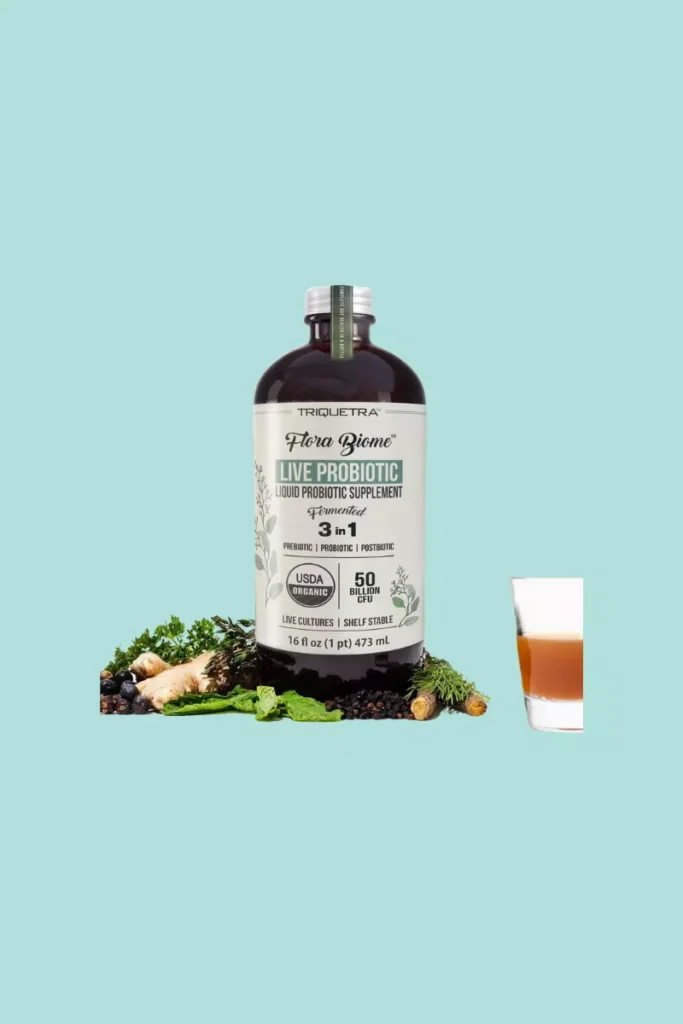
Ora Organic Prebiotic and Probiotic Powder Supplement
Ora Organic Prebiotic and Probiotic Powder Supplement
- Climate Pledge Friendly
- USDA Organic
- 1K+ bought in past month
- 4.3 out of 5 stars
- Price: $33.29 ($4.21 / Ounce)

Llama Naturals Real Fruit Prebiotic & Probiotic
Llama Naturals Real Fruit Prebiotic & Probiotic
- Climate Pledge Friendly
- USDA Organic
- Amazon’s Choice
- 1K+ bought in past month
- 4.4 out of 5 stars
- Price: $22.46 ($0.37 / Count)
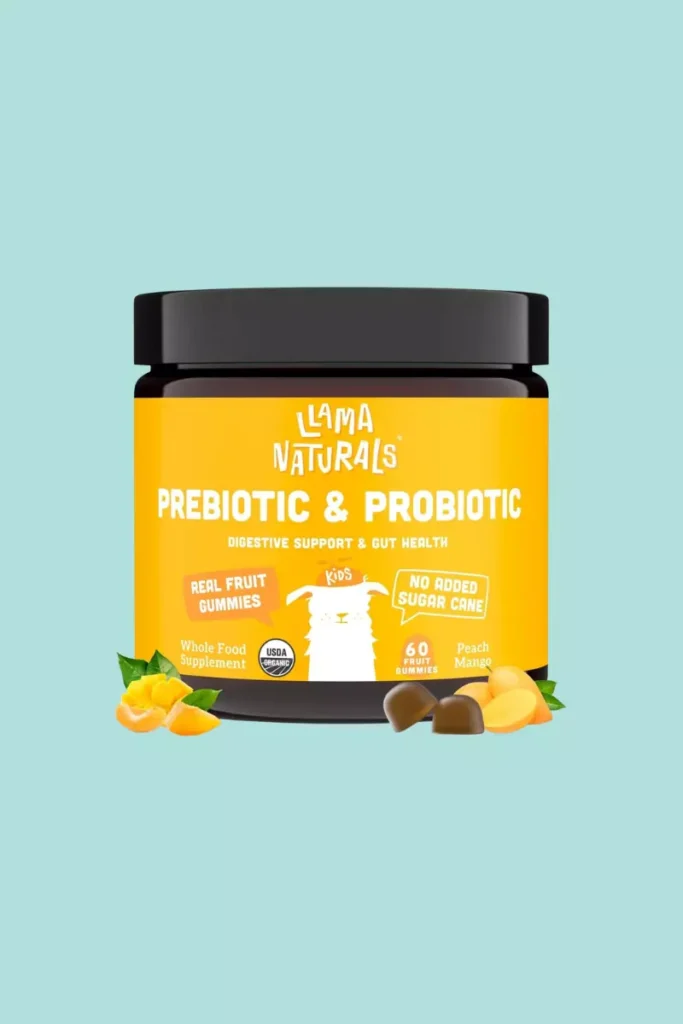
Frequently Asked Questions
Is it better to take a prebiotic or probiotic?
Who should not take prebiotics?
What are the signs you need probiotics?
Do you need both probiotics and prebiotics?
Can you take prebiotics and probiotics together?
References
- Eslamparast, Tannaz, et al. “Synbiotic Supplementation in Nonalcoholic Fatty Liver Disease: A Randomized, Double-Blind, Placebo-Controlled Pilot Study.” The American Journal of Clinical Nutrition, vol. 99, no. 3, Mar. 2014, pp. 535–42, https://doi.org/10.3945/ajcn.113.068890.
- Gibson, Glenn R., et al. “Expert Consensus Document: The International Scientific Association for Probiotics and Prebiotics (ISAPP) Consensus Statement on the Definition and Scope of Prebiotics.” Nature Reviews Gastroenterology & Hepatology, vol. 14, no. 8, June 2017, pp. 491–502, https://doi.org/10.1038/nrgastro.2017.75.
- Jorgenson, Margaret R., et al. “Efficacy and Safety of Probiotics and Synbiotics in Liver Transplantation.” Pharmacotherapy: The Journal of Human Pharmacology and Drug Therapy, vol. 38, no. 7, pp. 758–68, https://doi.org/10.1002/phar.2130. Accessed 24 Aug. 2023.
- “Opinion of the Scientific Committee on a Request from EFSA Related to a Generic Approach to the Safety Assessment by EFSA of Microorganisms Used in Food/Feed and the Production of Food/Feed Additives.” EFSA Journal, vol. 3, no. 6, https://doi.org/10.2903/j.efsa.2005.226. Accessed 24 Aug. 2023.
- Pandey, Kavita R., et al. “Probiotics, Prebiotics and Synbiotics- a Review.” Journal of Food Science and Technology, vol. 52, no. 12, Dec. 2015, pp. 7577–87, https://doi.org/10.1007/s13197-015-1921-1.
- Sanders, Mary Ellen, et al. “Probiotics and Prebiotics: Prospects for Public Health and Nutritional Recommendations.” Annals of the New York Academy of Sciences, vol. 1309, no. 1, Feb. 2014, pp. 19–29, https://doi.org/10.1111/nyas.12377.
- Skrzydło-Radomańska, Barbara, et al. “The Effectiveness of Synbiotic Preparation Containing Lactobacillus and Bifidobacterium Probiotic Strains and Short Chain Fructooligosaccharides in Patients with Diarrhea Predominant Irritable Bowel Syndrome—A Randomized Double-Blind, Placebo-Controlled Study.” Nutrients, vol. 12, no. 7, July 2020, https://doi.org/10.3390/nu12071999.
- Somani, Rozina, et al. “Peer Victimization and Experiences of Violence at School and at Home among School Age Children with Disabilities in Pakistan and Afghanistan.” Global Health Action, vol. 14, no. 1, Jan. 2021, p. 1857084, https://doi.org/10.1080/16549716.2020.1857084.
- Wang, Yanbo. “Prebiotics: Present and Future in Food Science and Technology.” Food Research International, vol. 42, no. 1, Jan. 2009, pp. 8–12, https://doi.org/10.1016/j.foodres.2008.09.001.
- Wong, Vincent Wai-Sun, et al. “Treatment of Nonalcoholic Steatohepatitis with Probiotics. A Proof-of-Concept Study.” Annals of Hepatology, vol. 12, no. 2, Mar. 2013, pp. 256–62, https://doi.org/10.1016/s1665-2681(19)31364-x.
- Zhang, Ming-Ming, et al. “Use of Pre-, pro- and Synbiotics in Patients with Acute Pancreatitis: A Meta-Analysis.” World Journal of Gastroenterology, vol. 16, no. 31, Aug. 2010, pp. 3970–78, https://doi.org/10.3748/wjg.v16.i31.3970.
Review date not set.
How we reviewed this article:
Latest on:
